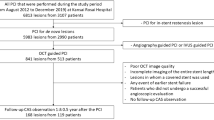Abstract
Patients with late/very-late stent thrombosis (ST) are at high risk of recurrent-ST. The mechanisms of recurrent-ST are largely unknown. The objective is to describe the 1-year optical coherence tomography (OCT) findings of patients suffering from late/very-late ST treated with intravascular imaging guided percutaneous coronary intervention (PCI). All consecutive patients with late/very-late ST undergoing intravascular imaging guided PCI were screened to undergo coronary angiography and OCT examination at 1 year. Patients were classified according to the observation of stent malapposition as most contributing cause of the ST. Thirty-four patients were included. Stent malapposition was observed in 17 (50%) and the remaining 17 cases were classified as: neoatherosclerosis (n = 9), underexpansion (n = 3) and unknown mechanism (n = 5). Patients with malapposition had a remarkable reduction of the malapposition volume (from 6.4 to 1.3 mm3; p = 0.02) during the ST procedure, but this was not fully corrected in 13 (76.5%). At 12 months, two patients of the malapposition group presented with uneventful target vessel re-occlusion. Persistent malapposition was observed in nine patients (60.0%). Major coronary evaginations (46.7 vs. 0%; p = 0.001) and uncovered struts (6.3 vs. 1.0%; p < 0.001) were also more frequent in patients with malapposition than without malapposition. None of the patients had thin-cap fibroatheroma neoatherosclerosis. Contributing causes of late/very-late ST are diverse and have different healing patterns at 12 months. Patients with stent malapposition treated with intravascular imaging guided PCI showed poor re-healing; but patients with other causes of the ST showed optimal stent healing as assessed by OCT.




Similar content being viewed by others
References
Cutlip DE, Windecker S, Mehran R et al (2007) Clinical end points in coronary stent trials: a case for standardized definitions. Circulation 115:2344–2351
van Werkum JW, Heestermans AA, de Korte FI et al (2009) Long-term clinical outcome after a first angiographically confirmed coronary stent thrombosis: an analysis of 431 cases. Circulation 119:828–834
Souteyrand G, Amabile N, Mangin L et al (2016) Mechanisms of stent thrombosis analysed by optical coherence tomography: insights from the national PESTO French registry. Eur Heart J 37:1208–1216
Taniwaki M, Radu MD, Zaugg S et al (2016) Mechanisms of very late drug-eluting stent thrombosis assessed by optical coherence tomography. Circulation 133:650–660
Gomez-Lara J, Salvatella N, Gonzalo N et al (2016) IVUS-guided treatment strategies for definite late and very late stent thrombosis. EuroIntervention 12:e1355–e1365
Adriaenssens T, Joner M, Godschalk T et al (2017) Optical coherence tomography findings in patients with coronary stent thrombosis: a report of the PREvention of Late Stent Thrombosis by an Interdisciplinary Global European Effort (PRESTIGE) Consortium. Circulation 136:1007–1021
Authors/Task Force m, Windecker S, Kolh P et al (2014) ESC/EACTS Guidelines on myocardial revascularization: The Task Force on Myocardial Revascularization of the European Society of Cardiology (ESC) and the European Association for Cardio-Thoracic Surgery (EACTS)Developed with the special contribution of the European Association of Percutaneous Cardiovascular Interventions (EAPCI). Eur Heart J 35:2541–2619
Gomez-Lara J, Brugaletta S, Jacobi F et al (2016) Five-year optical coherence tomography in patients with st-segment-elevation myocardial infarction treated with bare-metal versus everolimus-eluting stents. Circ Cardiovasc Interv 9:e003670
Taniwaki M, Windecker S, Zaugg S et al (2015) The association between in-stent neoatherosclerosis and native coronary artery disease progression: a long-term angiographic and optical coherence tomography cohort study. Eur Heart J 36:2167–2176
Russo RJ, Silva PD, Teirstein PS et al (2009) A randomized controlled trial of angiography versus intravascular ultrasound-directed bare-metal coronary stent placement (the AVID Trial). Circ Cardiovasc Interv 2:113–123
Tada T, Byrne RA, Simunovic I et al (2013) Risk of stent thrombosis among bare-metal stents, first-generation drug-eluting stents, and second-generation drug-eluting stents: results from a registry of 18,334 patients. JACC Cardiovasc Interv 6:1267–1274
Acibuca A, Gerede DM, Vurgun VK (2015) Bare-metal stent thrombosis two decades after stenting. Cardiovasc J Afr 26:e19–e21
Yamaji K, Raber L, Zanchin T et al (2016) Ten-year clinical outcomes of first-generation drug-eluting stents: the Sirolimus-Eluting vs. Paclitaxel-Eluting Stents for Coronary Revascularization (SIRTAX) VERY LATE trial. Eur Heart J 37:3386–3395
Waldo SW, Armstrong EJ, Yeo KK et al (2013) Procedural success and long-term outcomes of aspiration thrombectomy for the treatment of stent thrombosis. Cathet Cardiovasc Interv 82:1048–1053
de la Torre-Hernandez JM, Alfonso F, Hernandez F et al (2008) Drug-eluting stent thrombosis: results from the multicenter Spanish registry ESTROFA (Estudio ESpanol sobre TROmbosis de stents FArmacoactivos). J Am Coll Cardiol 51:986–990
de la Torre Hernandez JM, Alfonso F, Gimeno F et al (2010) Thrombosis of second-generation drug-eluting stents in real practice results from the multicenter Spanish registry ESTROFA-2 (Estudio Espanol Sobre Trombosis de Stents Farmacoactivos de Segunda Generacion-2). JACC Cardiovasc Interv 3:911–919
Gutierrez-Chico JL, Wykrzykowska J, Nuesch E et al (2012) Vascular tissue reaction to acute malapposition in human coronary arteries: sequential assessment with optical coherence tomography. Circ Cardiovasc Interv 5(S1–S8):20–29
Shimamura K, Kubo T, Akasaka T et al (2015) Outcomes of everolimus-eluting stent incomplete stent apposition: a serial optical coherence tomography analysis. Eur Heart J Cardiovasc Imaging 16:23–28
Guagliumi G, Sirbu V, Musumeci G et al (2012) Examination of the in vivo mechanisms of late drug-eluting stent thrombosis: findings from optical coherence tomography and intravascular ultrasound imaging. JACC Cardiovasc Interv 5:12–20
Funding
This study was funded by Abbott Vascular Spain.
Author information
Authors and Affiliations
Corresponding author
Ethics declarations
Conflict of interest
None of the authors declare conflict of interest with the present study.
Ethical approval
All procedures were in accordance with the ethical standards of the local ethic´s committee and with the 1964 declaration of Helsinki and its later amendments.
Electronic supplementary material
Below is the link to the electronic supplementary material.
Rights and permissions
About this article
Cite this article
Ñato, M., Gomez-Lara, J., Romaguera, R. et al. One-year optical coherence tomography findings in patients with late and very-late stent thrombosis treated with intravascular imaging guided percutaneous coronary intervention. Int J Cardiovasc Imaging 34, 1511–1520 (2018). https://doi.org/10.1007/s10554-018-1372-7
Received:
Accepted:
Published:
Issue Date:
DOI: https://doi.org/10.1007/s10554-018-1372-7




